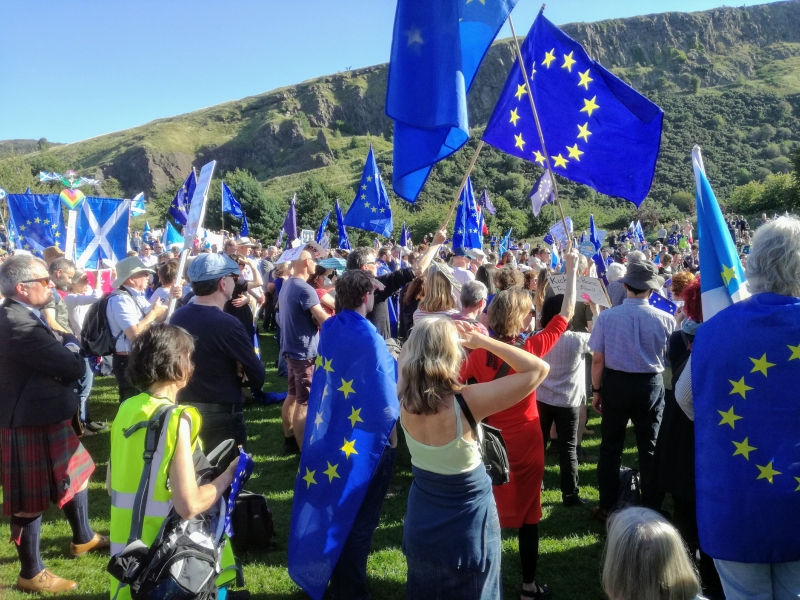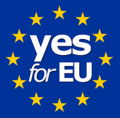IT’S more important than ever to keep flying the flag of Europe. What follows is the untold story of the flag, human rights, and the campaign for independence.

The new Rwanda Bill is an appalling example of the UK Government’s readiness to ride roughshod over human rights
and the rule of law. It orders British judges to ignore sections of the Human Rights Act, including the right not to be
tortured, and to ignore international laws, in particular the Refugee Convention. Several Tory politicians have even
advocated for the UK to leave the European Convention on Human Rights (ECHR).
What’s the link with the “EU flag”? It’s true that the blue flag with a circle of yellow stars is the flag of the EU, but
that’s not how it originated, and it has an important back story which everyone needs to know if they are to hold an
informed attitude towards Europe and an independent Scotland’s future place in it. The Flag of Europe – to give it its
correct title – is a symbol of human rights, peace, democracy and the rule of law. If ever we needed a visible sign of
Scotland’s commitment to these values, it’s now.
The flag was designed for the Council of Europe (CoE) in 1955, decades before it was adopted in 1986 by the
European Economic Community, the organisation which later developed into the EU as we know it today. The CoE
itself had been created in 1949 in the aftermath of World War Two, pre-dating even the earliest origins of the EU,
which lay in the European Coal and Steel Community formed in 1951. It was established with the noble aim of
creating “a Europe of peace founded on the values of human rights, democracy and the rule of law”. It was, and still
is, a peace project. Its key focus is promoting and protecting human rights – this is useful to know, at a time when
arguably the greatest threat from the UK Government is its erosion of our human rights.
The CoE is a separate organisation from the EU, but the two cooperate closely. The EU is “the main institutional
partner of the CoE in political, legal, and financial terms”. Their relationship is described as “a strategic partnership,
which draws on a long tradition of cooperation based on their shared values: human rights, democracy and the rule
of law.” Indeed, all 27 EU countries are CoE members and no country has joined the EU without first joining the CoE.
The latter has 46 members in total including the UK, whose CoE membership was unaffected by Brexit. The sharing
of the Flag of Europe by the two organisations demonstrates that connection.
How is this story of the flag relevant to Scotland’s constitutional question? The answer lies in those values that the
flag represents. They are values that we Scots embrace. We have elected a Scottish Government that promotes
peace, human rights, democracy and the rule of law, ie the very values set out by the CoE and EU. The same cannot
be said of the UK Government given, for example, their failure to call for a ceasefire in Gaza, their overruling
of Holyrood’s democratic decisions, their unlawful prorogation of the Westminster Parliament and disregard of
international law, and, right now, their Rwanda Bill and threat to withdraw from the ECHR. In contrast, the Yes
movement’s vision of a future independent Scotland is surely one that shares the values of the CoE and the EU.
In fact, attitudes to Europe have become central to the independence campaign: the rock-solid evidence of Brexit
harm, and heightened awareness of what we have lost, makes the return to the EU a clearly desirable goal for more
than 70% of Scots, and independence is widely agreed to be the best or only route for doing so in the foreseeable
future. Pollsters tell us that the prospect of Scotland’s EU membership is key in turning many Scots from No to Yes.
At the march and rally for an independent Scotland in the EU, held by Believe in Scotland and Yes for EU in Edinburgh
in September, many folk who took part said they were No voters in 2014 but absolutely determined to get back to
the EU and therefore tending towards Yes.
So let’s see the flag in a different light: it’s not just “the EU flag”, but a meaningful, visible symbol of the values that we aspire to as an independent nation, and which we will work together with our European neighbours to realise in practice. Let’s keep reminding ourselves of those values, by ensuring that the Flag of Europe is flown and celebrated all across Scotland!
Morag Williamson, Convenor, Yes for EU
